Abstract
The presence of Fc receptors for IgE on epidermal Langerhans cells (LC) from patients with atopic dermatitis (AD) was demonstrated by three different types of experiments. Firstly, cell-bound IgE on LC was removed by acid elution and restored by highly purified human myeloma IgE (IgE kappa). Secondly, after pepsin digestion of cell-bound IgE the number of LC staining with anti-human light chain (kappa, lambda) antibodies significantly decreased in contrast to the number of LC staining with anti-human epsilon heavy chain antibody. Thirdly, LC formed rosettes with sheep red blood cells (SRBC) coated with IgE kappa. Epidermal LC from normal non-atopic controls, did not form rosettes with SRBC-IgE. The SRBC-IgE rosette formation could be inhibited by preincubation with IgE kappa and BB10 (MoAb directed against the Fc receptor for IgE on human eosinophils, platelets and macrophages), but also with human IgG, whereas the SRBC-IgG rosette formation could be inhibited neither by IgE kappa nor by BB10. Both the SRBC-IgE and the SRBC-IgG rosette formation could be inhibited by OKT6 (anti-CD1) antibody. The results of inhibition studies with OKT6 antibody on the reconstitution of IgE on epidermal LC after acid elution suggest an associated expression of the CD1 antigen and the Fc receptor for IgE.
Full text
PDF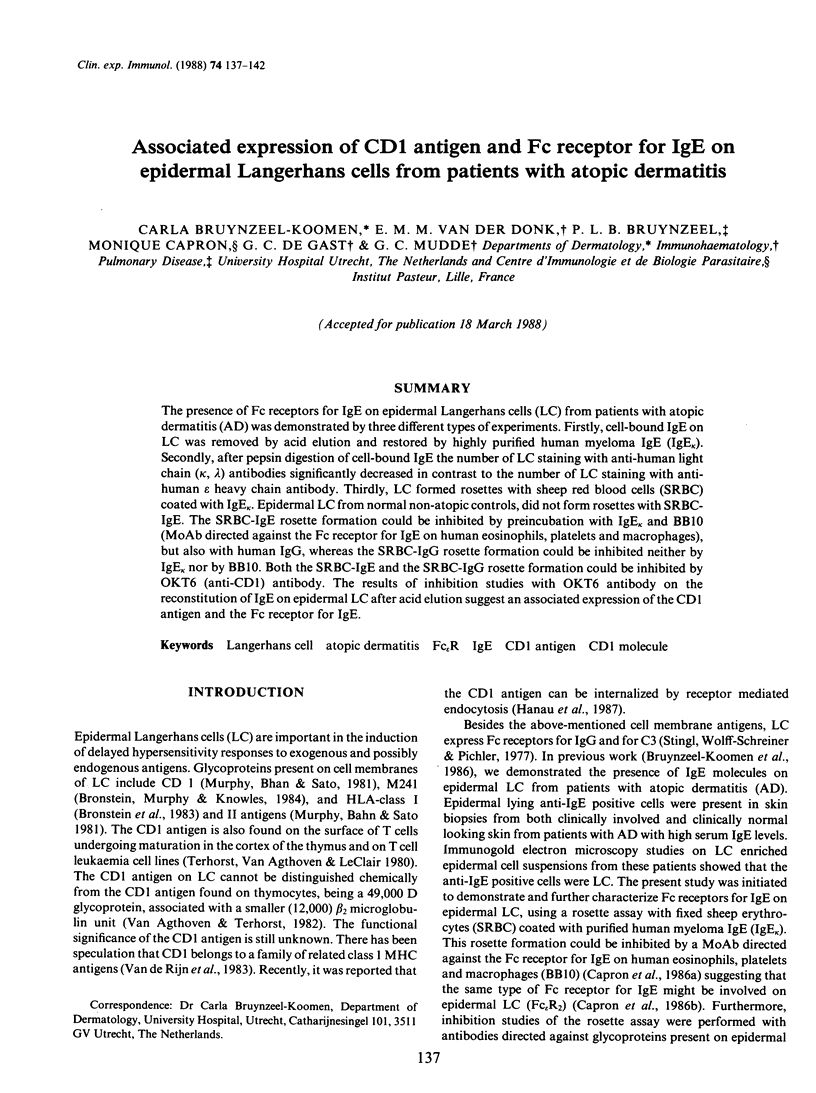
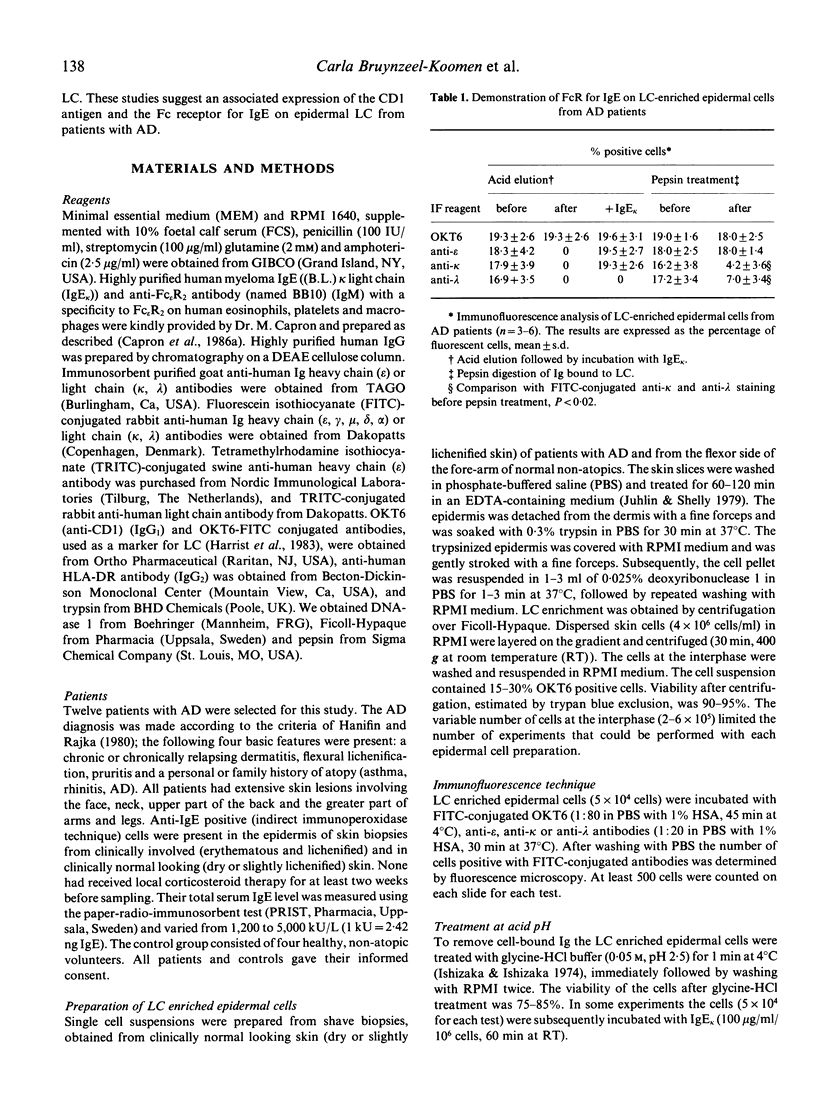
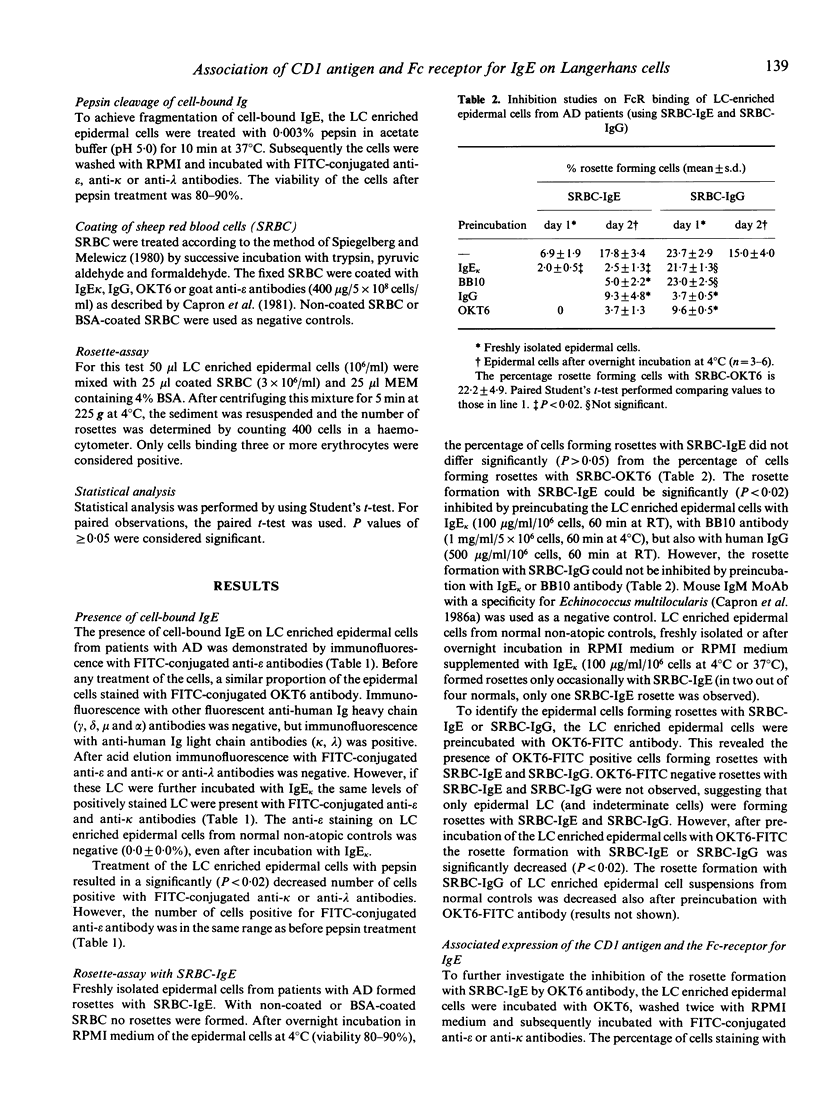
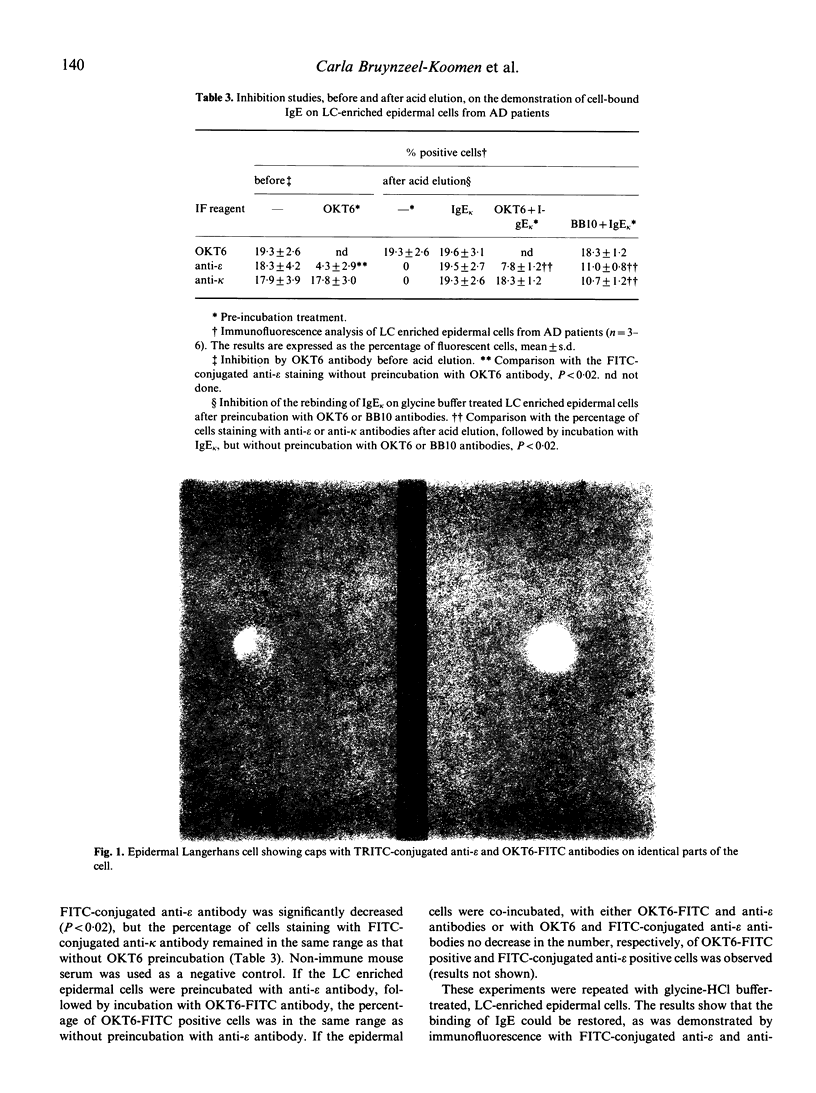
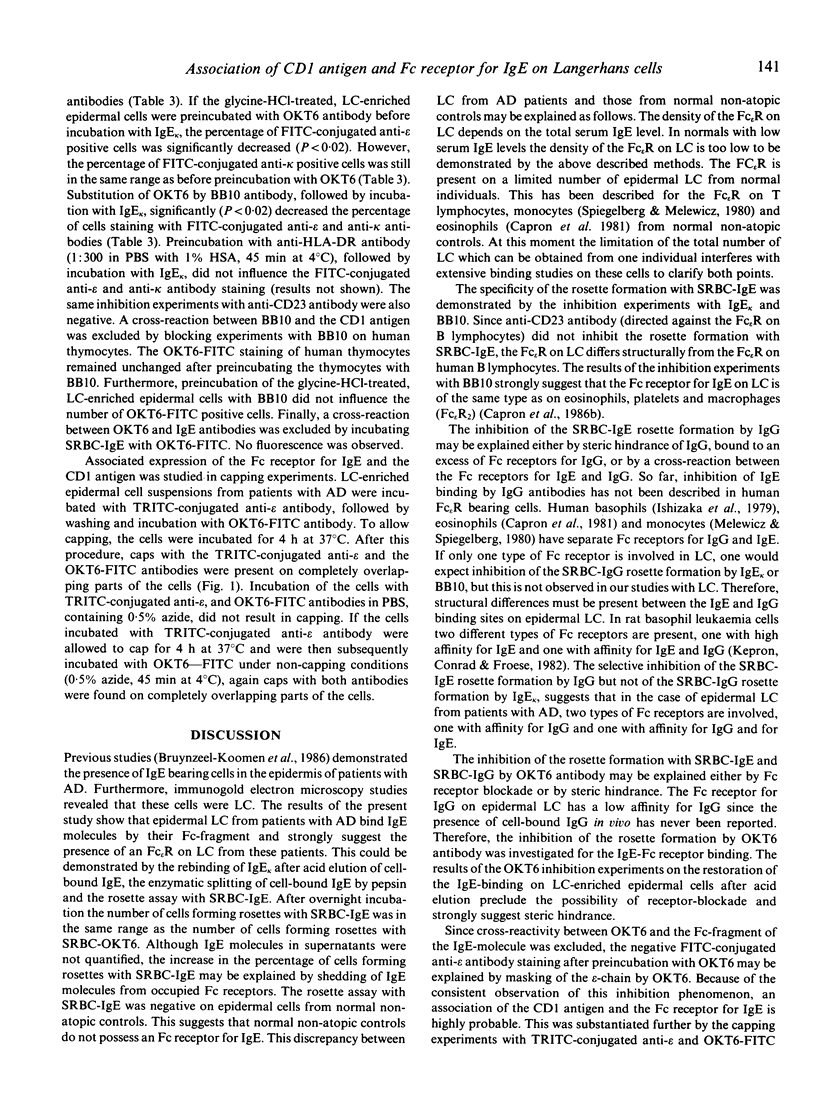
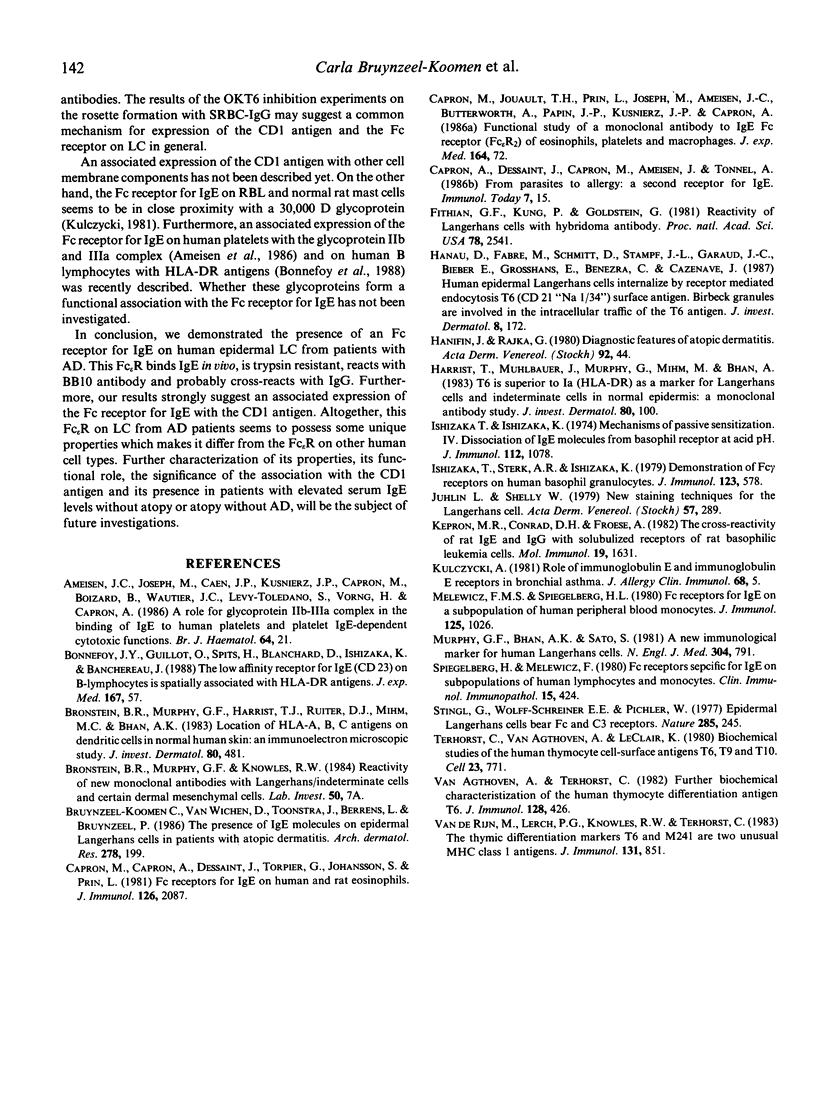
Images in this article
Selected References
These references are in PubMed. This may not be the complete list of references from this article.
- Ameisen J. C., Joseph M., Caen J. P., Kusnierz J. P., Capron M., Boizard B., Wautier J. L., Levy-Toledano S., Vorng H., Capron A. A role for glycoprotein IIb-IIIa complex in the binding of IgE to human platelets and platelet IgE-dependent cytotoxic functions. Br J Haematol. 1986 Sep;64(1):21–32. doi: 10.1111/j.1365-2141.1986.tb07570.x. [DOI] [PubMed] [Google Scholar]
- Bronstein B. R., Murphy G. F., Harrist T. J., Ruiter D. J., Mihm M. C., Jr, Bhan A. K. Location of HLA-A,B,C antigens in dendritic cells of normal human skin: an immunoelectron microscopic study. J Invest Dermatol. 1983 Jun;80(6):481–484. doi: 10.1111/1523-1747.ep12534932. [DOI] [PubMed] [Google Scholar]
- Bruynzeel-Koomen C., van Wichen D. F., Toonstra J., Berrens L., Bruynzeel P. L. The presence of IgE molecules on epidermal Langerhans cells in patients with atopic dermatitis. Arch Dermatol Res. 1986;278(3):199–205. doi: 10.1007/BF00412924. [DOI] [PubMed] [Google Scholar]
- Capron M., Capron A., Dessaint J. P., Torpier G., Johansson S. G., Prin L. Fc receptors for IgE on human and rat eosinophils. J Immunol. 1981 Jun;126(6):2087–2092. [PubMed] [Google Scholar]
- Capron M., Jouault T., Prin L., Joseph M., Ameisen J. C., Butterworth A. E., Papin J. P., Kusnierz J. P., Capron A. Functional study of a monoclonal antibody to IgE Fc receptor (Fc epsilon R2) of eosinophils, platelets, and macrophages. J Exp Med. 1986 Jul 1;164(1):72–89. doi: 10.1084/jem.164.1.72. [DOI] [PMC free article] [PubMed] [Google Scholar]
- Fithian E., Kung P., Goldstein G., Rubenfeld M., Fenoglio C., Edelson R. Reactivity of Langerhans cells with hybridoma antibody. Proc Natl Acad Sci U S A. 1981 Apr;78(4):2541–2544. doi: 10.1073/pnas.78.4.2541. [DOI] [PMC free article] [PubMed] [Google Scholar]
- Hanau D., Fabre M., Schmitt D. A., Stampf J. L., Garaud J. C., Bieber T., Grosshans E., Benezra C., Cazenave J. P. Human epidermal Langerhans cells internalize by receptor-mediated endocytosis T6 (CD1 "NA1/34") surface antigen. Birbeck granules are involved in the intracellular traffic of the T6 antigen. J Invest Dermatol. 1987 Aug;89(2):172–177. doi: 10.1111/1523-1747.ep12470555. [DOI] [PubMed] [Google Scholar]
- Harrist T. J., Muhlbauer J. E., Murphy G. F., Mihm M. C., Jr, Bhan A. K. T6 is superior to Ia (HLA-DR) as a marker for Langerhans cells and indeterminate cells in normal epidermis: a monoclonal antibody study. J Invest Dermatol. 1983 Feb;80(2):100–103. doi: 10.1111/1523-1747.ep12531695. [DOI] [PubMed] [Google Scholar]
- Ishizaka T., Sterk A. R., Ishizaka K. Demonstration of Fcgamma receptors on human basophil granulocytes. J Immunol. 1979 Aug;123(2):578–583. [PubMed] [Google Scholar]
- Juhlin L., Shelley W. B. New staining techniques for the Langerhans cell. Acta Derm Venereol. 1977;57(4):289–296. [PubMed] [Google Scholar]
- Kepron M. R., Conrad D. H., Froese A. The cross-reactivity of rat IgE and IgG with solubilized receptors of rat basophilic leukemia cells. Mol Immunol. 1982 Dec;19(12):1631–1639. doi: 10.1016/0161-5890(82)90274-7. [DOI] [PubMed] [Google Scholar]
- Kulczycki A., Jr Role of immunoglobulin E and immunoglobulin E receptors in bronchial asthma. J Allergy Clin Immunol. 1981 Jul;68(1):5–14. doi: 10.1016/0091-6749(81)90116-0. [DOI] [PubMed] [Google Scholar]
- Melewicz F. M., Spiegelberg H. L. Fc receptors for IgE on a subpopulation of human peripheral blood monocytes. J Immunol. 1980 Sep;125(3):1026–1031. [PubMed] [Google Scholar]
- Murphy G. F., Bhan A. K., Sato S., Mihm M. C., Jr, Harrist T. J. A new immunologic marker for human Langerhans cells. N Engl J Med. 1981 Mar 26;304(13):791–792. doi: 10.1056/NEJM198103263041320. [DOI] [PubMed] [Google Scholar]
- Stingl G., Wolff-Schreiner E. C., Pichler W. J., Gschnait F., Knapp W., Wolff K. Epidermal Langerhans cells bear Fc and C3 receptors. Nature. 1977 Jul 21;268(5617):245–246. doi: 10.1038/268245a0. [DOI] [PubMed] [Google Scholar]
- Terhorst C., van Agthoven A., LeClair K., Snow P., Reinherz E., Schlossman S. Biochemical studies of the human thymocyte cell-surface antigens T6, T9 and T10. Cell. 1981 Mar;23(3):771–780. doi: 10.1016/0092-8674(81)90441-4. [DOI] [PubMed] [Google Scholar]
- van Agthoven A., Terhorst C. Further biochemical characterization of the human thymocyte differentiation antigen T6. J Immunol. 1982 Jan;128(1):426–432. [PubMed] [Google Scholar]
- van de Rijn M., Lerch P. G., Knowles R. W., Terhorst C. The thymic differentiation markers T6 and M241 are two unusual MHC class I antigens. J Immunol. 1983 Aug;131(2):851–855. [PubMed] [Google Scholar]



